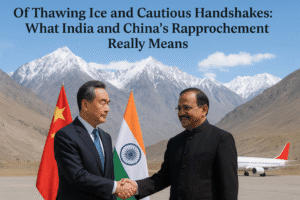Of Thawing Ice and Cautious Handshakes: What India and China’s Rapprochement Really Means
In a significant thaw of longstanding tensions, India and China have agreed to resume direct flights and bolster economic ties, marking a cautious step toward rapprochement. The agreement, forged during high-level diplomatic talks, also includes plans to reopen border trade points and facilitate visas, reconnecting people and commerce after a four-year freeze. Beyond economics, discussions tackled the core issue of their disputed Himalayan border, focusing on troop pullbacks and establishing a new working group for demarcation talks.
The dialogue notably addressed critical environmental concerns, with China agreeing to share hydrological data on the Brahmaputra River, a vital lifeline for millions downstream. This diplomatic shift is driven by pragmatic necessity, as both nations seek to stabilize a volatile region amid a complex global geopolitical landscape. However, the détente remains fragile, built on managing competition rather than resolving deep-seated strategic rivalries.
The move signifies a mature effort to install guardrails on a contentious relationship, prioritizing regional stability while acknowledging that fundamental trust must still be earned.

Of Thawing Ice and Cautious Handshakes: What India and China’s Rapprochement Really Means
The Himalayan air, thin and frigid, has long been charged with more than just altitude. For years, it has carried the tension of a standoff between the world’s two most populous nations. But this week, a subtle yet significant shift occurred. The high-altice whir of military drones is being joined, once again, by the familiar roar of commercial jet engines.
The resumption of direct flights between India and China, announced after a visit by Chinese Foreign Minister Wang Yi to New Delhi, is far more than a logistical footnote. It is the most visible symbol of a careful, calculated thaw in a relationship frozen solid since the deadly border clashes of 2020.
Beyond the Headlines: A Tapestry of Cautious Steps
While the resumption of travel is the headline grabber, the real story is woven into the finer details of the diplomatic talks:
- The Border: The Unhealed Wound: Talks between Wang and India’s National Security Advisor, Ajit Doval, went beyond pleasantries. They discussed tangible, albeit complex, issues: troop pullbacks from contentious Himalayan positions and the Sisyphean task of border delimitation. The agreement to form a new working group specifically for border affairs signals a move from posturing to problem-solving, however gradual.
- Economics as a Bridge: Beijing’s promise to address India’s need for critical items like rare earths (essential for electronics and defense) and tunnel-boring machines (crucial for infrastructure) is a classic Chinese gesture of economic diplomacy. It’s a pragmatic offer, acknowledging that business can build bridges where politics has built walls.
- Water Wars Averted? One of the most consequential, yet underreported, outcomes was on the issue of the Brahmaputra River. India strongly raised concerns about China’s mega-dam on the Yarlung Tsangpo (as the river is known in Tibet), a lifeline for millions downstream. China’s agreement to share emergency hydrological data, while not new, is a vital confidence-building measure. It’s a nod to the stark reality that geography inextricably links their fates.
The Ghost in the Room: Why Now?
This rapprochement isn’t born of sudden affection. It’s a strategic recalibration driven by shared and individual pressures.
For both nations, the unpredictable nature of global politics, particularly the posture of the United States under a renewed Trump administration, creates a powerful incentive to stabilize their own backyard. A contained bilateral relationship allows each to focus on other pressing economic and strategic challenges.
For India, a stable northern border is paramount to its ambitions as a rising global power and a counterbalance to China in the Indo-Pacific. For China, managing multiple fronts of tension—from the U.S. to its own economic headwinds—makes de-escalation with a giant neighbor a pragmatic necessity.
A Thaw, Not a Summer
It is crucial to temper optimism with a heavy dose of realism. The border dispute remains a deep, structural fault line. Trust, once shattered, is not rebuilt with a single meeting or a new flight route. The massive troop deployments remain. The fundamental strategic rivalry for influence in Asia persists.
This is a process of managing competition, not ending it. It is an agreement to install guardrails on a dangerous highway, not to change the destination.
The Human Dimension: What It Means for People
For the thousands of students, families, and businesspeople stranded by the four-year freeze, the reopening of skies is a personal lifeline restored. It reconnects loved ones and reopens channels of commerce that were forced onto costly and inefficient indirect routes. This is the immediate, human value—a return to a semblance of normalcy in a relationship that is anything but normal.
The upcoming visit of Prime Minister Modi to China for the Shanghai Cooperation Organisation summit will be the next critical test. Will the handshakes be warm, and the conversations productive? Or will it be a stage for more performative diplomacy?
The resumption of flights between Delhi and Beijing is a signal. It tells the world that two giants have chosen to step back from the brink and engage in a difficult, messy, but necessary dialogue. They are not allies, nor are they necessarily friends. But for now, they have decided they can no longer afford to be outright adversaries. The journey towards a stable peace is long, but for the first time in years, the wheels are up.
You must be logged in to post a comment.